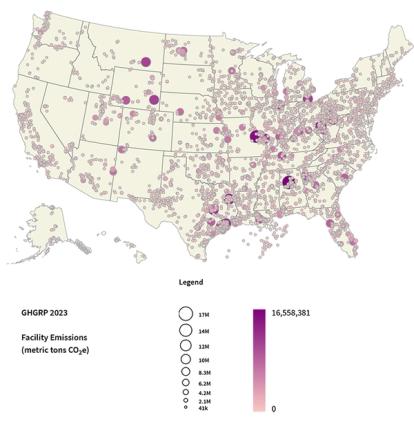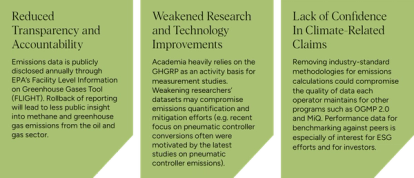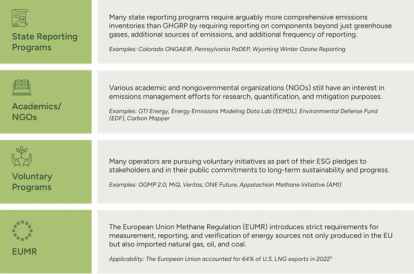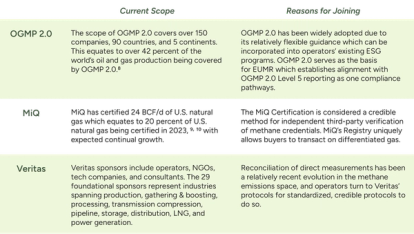
Cultural heritage: Indigenous and cultural heritage values driving sustainable development
by Flavia Kiperman
View post

The Greenhouse Gas Reporting Program (GHGRP), a longstanding emissions reporting program, is under reconsideration. What does this mean for the oil and gas industry, voluntary initiatives, and ongoing research?
The GHGRP (codified at 40 CFR Part 98) was established by the U.S. Environmental Protection Agency (EPA) in 2009. The GHGRP is considered one of the most comprehensive and detailed emissions reporting programs in the world, providing a national inventory of facility-level emissions. It has served as a model for other countries and is the basis for international reporting under the UN Framework Convention on Climate Change (UNFCC). More than 8,000 facilities [1] including petroleum and natural gas systems, which emit greater than 25,000 mt CO2e are required to submit annual greenhouse gas data reports to EPA; this threshold reduces the reporting burden on small operators while still capturing data on the largest man-made emission sources in the U.S. Consequently, the EPA estimates that 85-90% of annual man-made U.S. greenhouse gas emissions have been reported under the program [2], so recently proposed changes to Subpart W reporting requirements have sparked considerable interest and inquiry across the country.

The EPA has released substantial amendments to the GHGRP and other emissions-related programs throughout 2025 in response to President Trump’s Executive Order 14192, “Unleashing Prosperity Through Deregulation.” Most recently, on September 12, 2025, the EPA proposed to remove program obligations for all sectors outside of the petroleum and natural gas industry segments. This change would eliminate all GHGRP reporting requirements for industries, including but not limited to landfills, steel production, petrochemical production, and underground coal mines. Pertaining to the petroleum and natural gas industry segments under Subpart W, the proposed amendments are to:
Other GHGRP Subparts, including Subpart C and Subpart Y, are relevant to the oil and gas industry. These Subparts contain emissions and activity data on combustion and refinery processes, which can be an important part of the facility emissions profile. These Subparts are proposed to be entirely eliminated.
The report for the remaining nine segments was delayed rather than removed because the Waste Emission Charge (WEC), originally put in place by the Inflation Reduction Act [3], was delayed until 2034 under the Big Beautiful Bill Act [4]. The WEC is a financial obligation for oil and gas operators emitting above an established methane intensity, requiring them to pay a per-ton emissions overage fee by leveraging reported Subpart W data for the calculated emissions intensity. Should Congress completely repeal the WEC, it is reasonably anticipated that the current administration would likely propose permanently removing the obligation for the remaining nine segments of Subpart W, as per press statements promising deregulation of American energy [5].
The proposed amendments will shift the responsibility from the EPA towards operators to seek independent verification and assurance of their data, whereas the EPA has historically acted as this independent source. Other incidental consequences include reducing transparency and accountability of oil and gas operators, weakening research and technology improvements, and reducing confidence in climate-related claims for ESG efforts.

Many of SLR’s Clients have stated that they will continue to annually calculate and publicly disclose their greenhouse emissions despite the rollback of these regulations.
While GHGRP represents one of the largest emissions reporting initiatives in the U.S., it is not the only program that operators are obligated to report under. Even in a non-GHGRP world, some operators will continue to report emissions to state regulators in states like California, Colorado, New Mexico, and Pennsylvania. But not all states require reporting, and therefore gaps will exist in major producing basins such as the Permian, Bakken, Eagle Ford, and Haynesville.
There are also various voluntary initiatives, such as NGSI, The Environmental Partnership, OneFuture, and OGMP 2.0, where companies will continue to report on greenhouse gas emissions. Many of these programs were built based on the methodologies in the GHGRP. These programs mean some data will continue to come in from basins where there is a regulatory gap, but the publicly available data from these programs is often aggregated at the company or program level and not as granular as the GHGRP. Further, since these programs are voluntary, they may represent the best-performing operators in a basin rather than the average.
We have summarized some of the venues we expect to continue to see greenhouse gas emissions reporting, regardless of the EPA GHGRP rollback, in Figure 3. However, even with these programs, there will be a gap in oil and gas industry greenhouse gas emissions data. The GHGRP was a centralized, easily accessible data source for both emissions and activity data, which required reporting in a common format and basis.

Recent evolutions in the European methane policy will have a monumental impact on any U.S.-based operator that has coal, oil, or natural gas placed on the Union market. The European Union accounted for 64% of U.S. LNG exports in 2022 [6]. The European Union Methane Regulation (EUMR) introduces strict requirements for the measurement, reporting, and verification of energy sources, including those not only produced in the EU but also imported natural gas, oil, and coal. Arguably more intensive of a reporting program than GHGRP, EUMR will obligate operators to conduct direct measurements and reconciliation of their emissions (largely in alignment with OGMP 2.0 Level 5 reporting) to verify their emissions using credible third-party auditors at a reasonable level of assurance. Beyond verification, operators are also expected to mitigate their emissions to support the EU’s commitment to the Global Methane Pledge, aiming for a 30% reduction in emissions compared to 2020 by 2030 [7]. Under the EUMR Article 30, a methane transparency database will be established to publish the methane emissions intensity of Member States, Union producers, and gas imported from third countries that are placed on the Union market.
Looking beyond standing obligatory reporting programs, many operators are pursuing voluntary initiatives as part of their ESG pledges to stakeholders and in their public commitments to long-term sustainability and progress. SLR continues to see expanding interest from clients in voluntary programs such as OGMP 2.0, MiQ, GTI Veritas, and more.

It is apparent that greenhouse gas reporting efforts are not dissolving alongside the potential rollback of GHGRP. Other reporting programs, such as state reporting and EUMR, are expected to continue driving operators’ greenhouse gas emissions reporting. More so, SLR has witnessed a surge of interest in voluntary methane initiatives as operators remain committed to their ESG pledges, stakeholders, and public commitments to sustainability. SLR is uniquely positioned in the greenhouse gas space, having partnered with dozens of oil and gas clients nationwide to address these recent policy changes. We remain committed to helping our clients navigate the evolving regulatory landscape with clarity and confidence.
Interested in leveraging SLR's greenhouse gas and methane emission expertise to help your business maintain its emissions reporting program throughout regulation changes? Get in contact with our globally supported team to get started.
Contact us[1] https://www.epa.gov/ghgreporting/ghgrp-reported-data
[2] https://www.epa.gov/system/files/documents/2023-08/ghgrp-overview-fact-sheet.pdf
[3] Inflation Reduction Act of 2022, U.S.C §60113, https://www.congress.gov/117/plaws/publ169/PLAW-117publ169.pdf
[4] Big Beautiful Bill Act, 4 U.S.C §60012, https://www.congress.gov/119/plaws/publ21/PLAW-119publ21.pdf
[5] https://www.epa.gov/newsreleases/epa-launches-biggest-deregulatory-action-us-history
[6] https://www.eia.gov/todayinenergy/detail.php?id=55920
[7] https://eur-lex.europa.eu/eli/reg/2024/1787/oj/eng
[8] https://www.ogmpartnership.org/our-member-companies
[9] https://miq.org/

by Flavia Kiperman

by Jasper Schrijvers , Matthew Hoare

by Clodagh Connolly, Nicola Inge, Andres Schottlaender